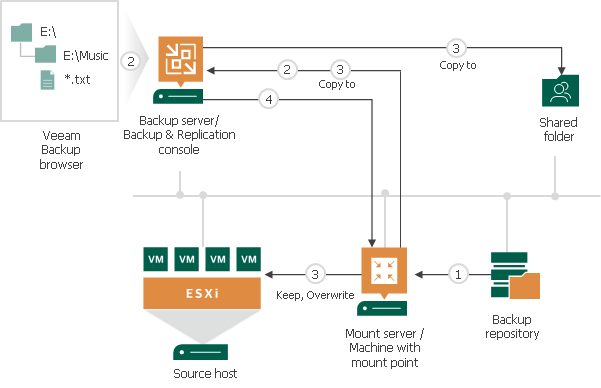 This is an archive version of the document. To get the most up-to-date information, see the current version.
This is an archive version of the document. To get the most up-to-date information, see the current version.Restore from Microsoft Windows File Systems (FAT, NTFS or ReFS)
The restore from FAT, NTFS and ReFS method helps you restore files from Microsoft Windows VMs with NTFS, FAT and ReFS file systems. For the full list of supported file systems, see Platform Support.
You can restore files to the original or new location, work with the restored files using Microsoft Windows File Explorer or launch application item restore for the files. For more information, see Finalize Restore.
Note |
You can also recover guest OS files of VMware vSphere VM disks directly from storage snapshots. |
How Restore Works
When you perform file-level restore, Veeam Backup & Replication performs the following operations:
- Veeam Backup & Replication creates a mount point under the C:\VeeamFLR\<vmname> folder and mounts VM disks from the backup or replica to it. For more information on which machines Veeam Backup & Replication creates mount points, see File-Level Restore Scenarios and Mount Points.
To access VM disk content, Veeam Backup & Replication uses a separate program — Virtual Disk Driver (VDK) that is provided with the product. VM disks are not physically extracted from the backup file or VM replica. Veeam Backup & Replication emulates their presence on the backup server or Veeam Backup & Replication console. The backup file or VM replica itself remains in the read-only state.
- Veeam Backup & Replication launches the Veeam Backup browser on the Veeam Backup & Replication console. The Veeam Backup browser shows the content of disks mounted to the machine where the mount point is created.
You can browse the VM guest file system in the Veeam Backup browser and restore files or folders to the original or new location.
- Depending on whether you restore files or folders to the original or new location, the operations differ:
- If you restore to the original location, that is, select the Keep or Overwrite command.
The machine where the mount point is created connects to the VM over network or VIX API/vSphere Web Services if a connection over the network cannot be established.
- If you restore files to a new location, that is, select the Copy to command.
The machine where the mount point is created connects to the Veeam Backup & Replication console. The connection is performed over network or VIX API/vSphere Web Services if a connection over the network cannot be established. If you recover files to a shared folder, the Veeam Backup & Replication console connects to this folder.
- When the restore process is finished or the Veeam Backup browser is closed by timeout, Veeam Backup & Replication removes all the created mount points.
When you perform file-level restore, you can also open files in Microsoft Windows explorer to view file content. In this case, Veeam Backup & Replication creates an additional mount point on the Veeam Backup & Replication console. For more information on how to view file content, see Open Files in Microsoft Windows Explorer.

Related Topics